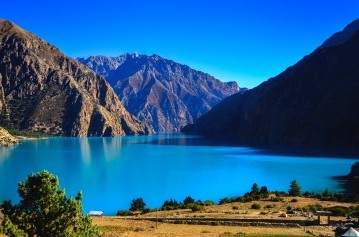
Dolpo Region: "Echoes of the Himalayas: Exploring Dolpo's Tibetan Tapestry"
The Dolpo Region is a hidden gem in Nepal, tucked away in the remote trans-Himalayan wilderness of the country. This captivating district is renowned for its untouched natural beauty, cultural richness, and rugged landscapes, making it a dream destination for adventurous travelers.
Situated in the far western part of Nepal, the Dolpo Region is bordered by the majestic Dhaulagiri Himalayas to the south and east, the Kanjiroba and Sisne Mountains to the west, and Tibet to the north. Its remote settlements and pristine wilderness have earned it the reputation of being the "Shangri-La of Nepal."
Why Trek in the Dolpo Region?
- Remote Settlements: Dolpo is home to remote and fascinating settlements that offer a glimpse into traditional Himalayan life. The region's inhabitants have preserved their unique culture and way of life for generations.
- Spectacular Landscapes: The Dolpo Region boasts stunning landscapes characterized by towering cliffs, rugged gorges, and rolling hills. The trail offers breathtaking views at every turn, making it a paradise for nature lovers and photographers alike.
- Dho-Tarap Valley: The trek to Dolpo typically begins in Juphal and leads trekkers north to the enchanting Dho-Tarap Valley. This valley is home to some of the highest human settlements in the world, providing a rare opportunity to experience remote mountain life firsthand.
- Numa La and Baga La Passes: Trekkers on the Dolpo trail will traverse high mountain passes, including Numa La and Baga La, which offer panoramic views of the surrounding Himalayas. These challenging yet rewarding sections of the trek are unforgettable experiences.
- Phoksundo Lake: The journey culminates at the breathtaking turquoise-blue Phoksundo Lake, a sacred body of water surrounded by towering cliffs and pristine forests. Its tranquil beauty is a highlight of any visit to Dolpo.
- Upper Dolpo: Beyond Lower Dolpo lies Upper Dolpo, another mesmerizing region characterized by wild and pristine landscapes. Trekkers can explore remote villages, ancient monasteries, and untouched wilderness in this remote corner of Nepal.
Popular Trekking Routes of the Langtang Region
- Lower Dolpo Trek: typically takes around two weeks to complete and offers an immersive journey through some of Nepal's most remote and untouched landscapes.
- Upper Dolpo Trek: For those seeking further adventure, Upper Dolpo presents an opportunity to explore even more rugged and pristine terrain.
Essential Information
- Best Time to Visit: The best time to trek in the Dolpo Region is during the spring (March to May) and autumn (September to November) when the weather is clear and stable, offering optimal trekking conditions.
- Permits: Trekkers need special permits to enter the Dolpo Region, which can be obtained through authorized trekking agencies in Nepal.
- Accommodation: Accommodation options in Dolpo range from basic teahouses to camping under the starry sky. Trekkers should be prepared for rustic conditions and limited facilities.
- Safety: Trekking in the Dolpo Region can be physically challenging and remote. Trekkers should be adequately prepared with proper gear, supplies, and a trained guide.
Embark on an unforgettable adventure to the Dolpo Region and discover Nepal's hidden Himalayan treasure. From remote settlements and rugged landscapes to sacred lakes and high mountain passes, Dolpo offers a journey of exploration and discovery like no other. Whether trekking through Lower Dolpo or venturing into the wilds of Upper Dolpo, this remote corner of Nepal promises an experience that will stay with you for a lifetime.
Experience the Dolpo Region Trek with Asian Adventure Treks & Expedition - Professional Planner for your vacations!
Featured trips for Dolpo Region
Easy trekking are basically for the beginners. This kind of treks is typically done in the lower hilly region of elevation below 3500 metre. The trails in this trek are generally vertical and walking time is 3 - 5 hours everyday.
Moderate types of trekking generally take place on the low altitude zone crossing the passes below the elevation of 4500 meters. Normally the walking is from 4 - 6 hours each day.
Hard kind of trekking routes crosses through the wild and adventurous trails and sometimes passes through the snow covered high passes between 4500 meters to 5500 meters. Usually the walks takes from 7-8 hours everyday.
Generally this types of routes are demanding long distance treks where the walks takes up to 9 hours each day. Each trail crosses at least one pass over 5500 meters frequently contains hardly ever explored regions. Challenging are the expedition types of activity.


